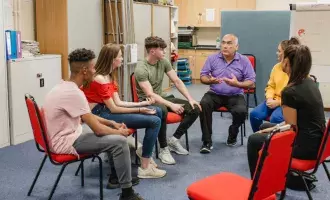From geopolitical instability and climate crises to technological advancement, our resilience is being tested more than ever before.
Whether in the public or private sectors, organisations are having their collective resilience tested by the very same factors impacting individuals. To combat this, organisations need several elements, foremost among them a workforce that is sufficiently skilled for tomorrow, not just today.
And yet, this is a huge challenge. Statistics from the UK Government & the OECD suggest that organisations are missing over 50% of the skills they need.
- The UK Government’s latest Employer Skills Survey found that 36% of job vacancies are due to a lack of skills within organisations.
- The OECD Skills for Jobs database indicates that 26% of the UK workforce is underqualified for their occupation, compared to an OECD average of 18%.
This represents a significant challenge for businesses, costing them £4.4bn annually, through recruitment fees, and upskilling underqualified employees, amongst other things. When the gap, and the costs of it, are so vast, it’s no wonder that organisations are turning their focus towards skills and becoming a ‘skills-based organisation’.
Our journey through skilled-based resilience
In recent months, I’ve been speaking to people across industries and sectors about the reality of being a skills-based organisation and its impact on resilience. The idea for this topic was sparked by a viral LinkedIn article written by Harald Overaa, which broke down the path to a multi-skilled workforce – often referred to as a ‘skills-based organisation’ – through a clear three-phase process, based on work by the Academy to Innovate HR.
To reflect on our journey through skills-based resilience, I’ll be sharing my biggest learnings from my conversations across the three phases.
Phase 1: Building the business case
‘T’-shaped people increase our capacity to meet demand. In episode 1 of our podcast series, I reflected on ‘T’-shaped skills, and the work of Jason Yip, Senior Agile Manager at Spotify. Yip explains the differences between various skill profiles:
- ‘T’-shaped people: Experts in at least one area, with general capabilities in many others.
- ‘I’-shaped people: Experts in a specific area, with minimal capability outside it. We primarily reward these types, due to our focus on having deep expertise in an area.
- Generalists: Capable across many areas, but not an expert in any one field. We typically lack these, although they do exist in some leadership positions.

Source: Jason Yip, 2018
One of the biggest cases for ‘T’-shaped people is their ability to create more capacity to deal with demand. I’ve seen this with many clients, and I’ll take the example of a call centre. They are consistently hiring new staff to deal with fluctuating customer demands that require different skills. Yet, they’ve the capacity within the team to cover the extra demand. The issue is that those people don’t have the skills, and even if they did, the organisation isn’t tracking them, so it can’t see the skills that already exist.
It’s a recurring story across industries – think about that Open University statistic from earlier; we’re spending £4.4 billion to tackle skills gaps. Imagine how much of that could be saved by focussing more on creating T-shaped skills and / or simply tracking the skills you have.
Phase 2: Identifying the skills you need
Engaging the right stakeholders is key. To transition from focusing on jobs to focusing on skills, it’s vital to identify the skills your organisation needs. In a podcast discussion about developing frameworks at Capita, Senior Learning Consultant and Skills Framework Creator Zia Aftab recommended speaking to every corner of the business:
- Senior leadership: Ensure you have at least one senior sponsor.
- Business unit representatives: Ask for their top 5 skills to create an organisation-wide priority list.
- HR: Understand the wider talent lifecycle and anticipate any future changes.
- Market and industry experts: Keep track of how customer demands are evolving and what skills your business will need to meet these changes.
Our obsession with jobs hinders internal mobility and recognising the skills we have. It’s one thing to identify the skills we need, but what about the skills we already have? In our webinar, organisational psychologist Steph Bright highlighted how our focus on jobs can prevent both individual progression and the filling of critical skills gaps within organisations: “People really look at the job spec and go ‘I can't do that’. ‘I don't have the skillset’. And when you dig, they do. They just don't know how to un-pick [their skills], pull out the example and apply it to another scenario.”
We are obsessed, arguably married, to our job title. For proof, just watch how people are introduced on any TV gameshow. Job titles are part of our identity, and that means we - and our organisations - see our skills within the parameters of our specific role, as opposed to understanding the underlying transferable skills.
It means we create a wall around each individual, within which only tasks specifically related to that title are completed. This rigidity is neither agile, nor adaptable, which are both integral to resilience. By shifting our focus from jobs to skills, we can better understand the plethora of transferable skills that exist within our teams and identify areas where we already have the capabilities to fill perceived gaps.
Non-perishable skills are the top priority across industries. Of all the public and private sector leaders surveyed on our recent webinar, only 30% say they have a clear view of the skills they need. During our live roundtable event, we asked some of these leaders for their priority skills:
- project management
- emotional intelligence
- critical thinking
- leadership
- cyber security
- data analysis
It’s no surprise that these are non-technical skills. Unlike technical skills, which can become obsolete or replaced by technology, these skills are non-perishable. They enable us to work effectively with both technology and each other, improving how we collaborate, learn and adapt to change. An NFER report suggests that by 2035, non-perishable skills will be the most sought-after skills in the workplace.
Phase 3: Implementing the change
Not everyone wants to develop their skillset, and that’s okay. Implementing the change includes developing people against the skills framework we have created. However, as Simon Gibson, Head of Talent at Center Parcs, explained during our webinar, we can’t expect everyone to want to learn new skills.
Leaders must democratise the skills strategy; let everyone access the information on the skills the organisation has now and how that will change in the future. This will ensure people are aware of changes that could impact their role long before it happens, giving them time and a reason to increase their skills in other areas. If employees choose not to upskill, then that’s their decision, but at least they know the risks with their role in advance of any significant changes, such as redundancies, are forced on them.
An outcomes-based focus represents true inclusivity. Implementing a skills-based organisation means clear visibility and validation of the skills everyone has. During our podcast conversation, inclusivity expert Johanne Penney stressed that we need to “focus on outcomes” as opposed to method, because true diversity means acknowledging that there is “more than one way to reach a goal.”
Therefore, to make it harder to delegate, reward and promote based on bias, Johanne recommends creating a clear, consistent way of measuring skills that is objective, and outcomes-based, to allow for diverse ways of working.
Technology is essential for mapping learning to your skills framework. In our podcast discussion on learning technologies, CEO of Filtered and skills mapping expert, Marc Zao-Sanders, explained the pitfalls of trying to connect your learning content to skills without the right technology: “Imagine linking just one [skill] to one piece of learning. It would take you an hour, if you had the expertise to do it…so, it just quickly becomes obvious that you can't do this on a manual basis.”
To use technology for content mapping effectively, Marc recommends focusing on five elements:
- Skills: The capabilities you require from your workforce.
- Content: Resources from internal or external sources, and in a range of formats.
- Tags: The words that explain what the content consists of, to be able to connect it to your skills.
- Discovery: Enable learners to discover the learning they need with ease and to develop in the way they want to.
- Data: Track and measure content usage, and its impact on skills development.
Want to learn more?
To hear more about any of these topics, you can:
- Listen to our podcast series, either on our website, or anywhere else you get your podcasts; just search for ‘The Big Questions Capita’
- Listen back to our panel discussion webinar: Unlocking Resilience: The Steps to Creating a Skills-Based Organisation
- Contact us at learning@capita.com - from culture change, to creating skills frameworks and developing priority skills, we are here to support your skills journey.
Take a look at how our learning and development capabilities can support your requirements:

James Eynon
Senior Learning Consultant & Leadership Coach
Since 2015, James has led various L&D initiatives, focusing on practical solutions for learning cultures, data impact, reskilling, and leadership. James’ pragmatic approach to both consultancy and facilitation has resulted in the creation of a new workplace culture model, in which hybrid working is an integral part.







